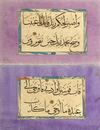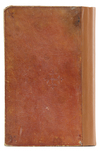AN OTTOMAN CALLIGRAPHIC ALBUM, WITH LATER ATTRIBUTION TO AHMED KARAHISARI, TURKEY, 15TH CENTURY
Black ink on gold-speckled paper, 6 folios, each with a panel of two lines of large strong black thuluth script, with gold and polychrome rosette verse markers, final folio with later attribution to Ahmed Karahisari in black tawqi' script, laid down on card with colored borders, in simple stamped brown morocco binding.
Calligraphy: 9.2 by 16.8 cm.
Folio: 16.8 by 26 cm.
CATALOGUE NOTE
Ahmed Karahisari (1468–1566), was an Ottoman calligrapher. Born, Ahmed Şemseddîn’dir, he became known as Karahisari after his place of birth, Karahisar. His date of birth is uncertain but is around 1468 or 1469. He went to Istanbul for his education, where he remained his whole life. After completing his Sufi scholarship, he took the chanting order. He served in the Imperial Court of Suleiman I, according to the Salary Books, which place him there in 1545, but his period of tenure is uncertain. Unlike most of the Ottoman calligraphers of his era, he did not follow the style of Sheikh Hamdullah. Instead, he wanted to reinvigorate the style of the Abbasid calligrapher, Yaqut al-Musta'simi (1221-98), which had dominated Islamic calligraphy prior to Hamdullah's innovations. Karahisari improved the best examples of Thuluth and Naskh scripts. However, apart from his students, his style was not widely accepted and was largely overshadowed by the developments made by Sheikh Hamdullah (1436–1520) and Hâfiz Osman (1642–1698). In terms of the technique and innovations made to the calligraphy, he is considered one of the three most important Ottoman calligraphers along with Sheikh Hamdullah and Hâfiz Osman. Some of the most impressive of the Qurans prepared in the Ottoman Palace Studios have been attributed to Ahmed Karahisari. His most important work is the Quran which he penned for Suleiman the Magnificent (reigned 1520-1566), which is preserved today at the Topkapi Palace.Other examples of his work are held in the Topkapi Museum and the Museum of Istanbul.
He died in Istanbul when he was well into his 90s, and was buried in the grave of Cemaleddin İshak Karamânî in Sütlüce.






